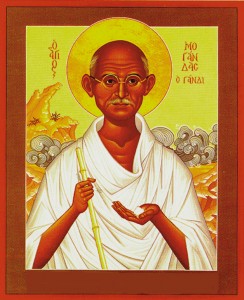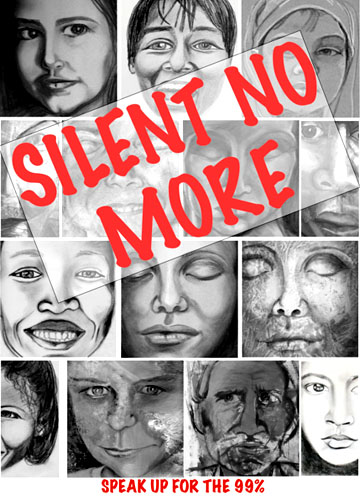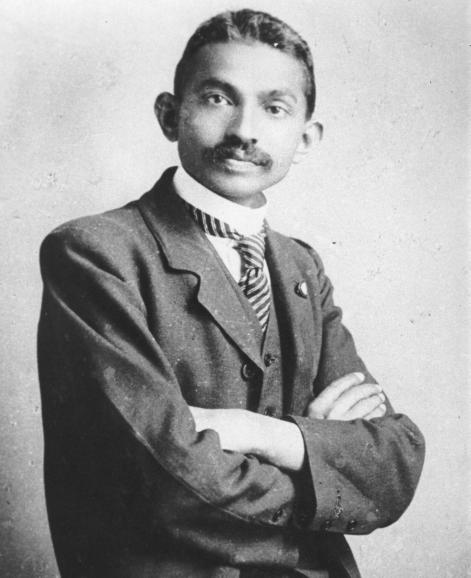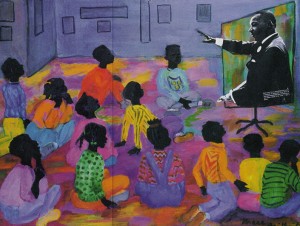by Lloyd I. Rudolph
My title is figurative, not literal; Gandhi never set foot on American soil. His presence is the result of American responses to his person, ideas, and practice. For most Americans, they were exotic, often alien, fascinating for some, threatening or subversive to others. This chapter analyses America’s reception and understanding of Gandhi by pursuing two questions: Is he credible’? Is he intelligible?
For a person to be credible, it must be possible to believe that this seemingly quixotic person is someone like ‘us’: someone who makes sense in terms of America’s cultural paradigms and historical experience. From the beginning many thought that Gandhi was putting ‘us’ on, that he was fooling us while fooling around. Was he for real or was he a fraud?
Read the rest of this article »
by Thomas Merton

It would be a serious mistake to regard Christian nonviolence simply as a novel tactic which is at once efficacious and even edifying, and which enables the sensitive person to participate in the struggles of the world without being dirtied with blood. Nonviolence is not simply a way of proving one’s point and getting what one wants without being involved in behavior that one considers ugly and evil. Nor is it, for that matter, a means which anyone legitimately can make use of according to his fancy for any purpose whatever. To practice nonviolence for a purely selfish or arbitrary end would in fact discredit and distort the truth of nonviolent resistance.
Read the rest of this article »
by John Dear
Like all of you, Thomas Merton has been one of my teachers, and it’s a blessing to reflect on his exemplary life and astonishing witness.
I’m 45, have been in the Jesuits almost 25 years now, went to college at Duke University, decided one day that I really did believe in God and that I wanted to give my whole life to God, and the next thing you know, I was entering the Jesuits. I’m still trying to figure out how that happened! Before I entered the Jesuits, I decided I better go see where Jesus lived, so I decided to make a walking pilgrimage through Israel, to see the physical lay of the land, only the day I left for Israel in June 1982, Israel invaded Lebanon and I found myself walking through a war zone.
Read the rest of this article »
by John S. Moolakkattu
 “Mohandas Gandhi of India”;
“Mohandas Gandhi of India”;
original icon by Robert Lentz;
thanks to Trinity Stores
Is Gandhi a human ecologist? If we go by the ideas generated by the environmental movement in India, which is strongly influenced by Gandhi, the answer is a definite ‘yes’. But Gandhi’s place in the ecological movement is yet to be established on a secure footing internationally. Even the recent Encyclopedia of Human Ecology edited by Julia R Miller et al. (2003) omitted Gandhi as one of its entries in its otherwise impressive list. Ecological consciousness, understandably, is a phenomenon that gained momentum only in the last four decades or so. But the roots of it can be traced to worldviews, traditions, culture, religion and folklore. Ecology is the science that focuses on the relationships between living organisms and their environment. Human ecology is about relationships between people and their environment. Human activities impact on ecosystems. Conversely, ecosystems are strongly influenced by the social system in which people live. Our worldview both as individuals and as society shapes the way we formulate our strategies for action (Marten 2001).
Read the rest of this article »
by Shinichi Yamamuro

“Philosopher’s Garden: Kyoto, Japan, 2012”; original photograph, by Michael Sawyer.
Non-violence often comes to mind when we think of the term ahimsa, which, for example, Gandhi used. The word himsa in Hindi means, “to inflict injury on a person,” in other words to hurt a person. The word ahimsa, “non-violence,” is formed by adding the negative adverb a. What exactly is “inflicting injury”? Naturally, it is easy to understand physical violence, such as war, in which people are harmed, but are there other ways of inflicting injury? If so, how should we understand non-violence?
Read the rest of this article »
by Terry Messman
“We found that during the period of 1900 to 2006, nonviolent resistance campaigns are about twice as effective as violent ones in achieving their goals. We also found that these trends hold even where most people expect nonviolent resistance to be ineffective—for instance, against dictatorships and highly repressive regimes.” Erica Chenoweth
In a groundbreaking effort to systematically study and compare success rates of violent and nonviolent social-change movements, Erica Chenoweth and Maria J. Stephan carefully researched 323 social-change campaigns from 1900 to 2006. Chenoweth and Stephan’s astonishing finding is that campaigns of nonviolent resistance are nearly twice as likely to succeed as violent uprisings.
 “Silent No More”. Poster art by Nora Tryon
“Silent No More”. Poster art by Nora Tryon
In their book, Why Civil Resistance Works: The Strategic Logic of Nonviolent Conflict, the authors found that far greater numbers of people from more diverse parts of society joined nonviolent campaigns than violent ones. This greater level of participation translates into more people who can demonstrate for change, and withdraw their cooperation from an unjust regime.
Read the rest of this article »
by Satish Kumar
When human beings consider themselves to be the masters of the earth and have dominion over it they are more likely to abuse it and exploit it.
Much of our conventional education is learning “about” nature. We study nature as something separate from us and as an object, which is useful to us. We seem to consider ourselves either masters of nature or, if more enlightened, then stewards of nature. We study nature because we wish to know our servant or our protectorate in order to make best use of nature for a prolonged period.

Ruud van EMPEL, Theatre # 2; Cibachrome photograph, 2010; 120 x 120 cm.;
courtesy, Flatland Gallery.
When human beings consider themselves to be the masters of the earth and have dominion over it they are more likely to abuse it and exploit it. Therefore, the environmentalists take a step in the right direction by considering themselves as stewards of the earth. Stewardship entails responsibility. In such a view of the environment people are more likely to conserve and care. However, both these views are anthropocentric. From both these points of view human beings are a superior species, having a higher status. Norwegian philosopher Arne Naess has named such a human centered relationship with the natural environment as “shallow ecology”.
Read the rest of this article »
by Metta Center for Nonviolence
By the year 1908 Gandhi realized that he needed a new term for the new force he was introducing into politics. “Passive resistance” was misleading, and nonviolence, the direct translation of the ancient Sanskrit term ahimsa was not yet in vogue (that would come some twenty years later). He held a contest and sadagraha or ‘clinging to the Real’ was selected, but then modified for grammatical reasons to Satyagraha. The great benefit of this term lay in the deep meaning of ‘satya’ in Indian languages: not just ‘true’ as opposed to false, but also ‘real’ as opposed to unreal (see his famous definition at the end of this article), and ‘good’ as opposed to harmful.

M. Gandhi c. 1908, the year he coined
the term satyagraha; photographer unknown.
The term Satyagraha is used in two senses: it can stand for the entire principle of nonviolence, or the active and resistant dimension of it, as opposed to mere petitioning or constructive program.
Read the rest of this article »
Posted on 15 August 2012 under
Theory.
An Open Letter to the Occupy Movement from Starhawk and the Alliance of Community Trainers.
Nonviolent direct action clearly dramatizes the difference between the corrupt values of the system and the values we stand for. Their institutions silence dissent, while we value every voice. They employ violence to maintain their system, while we counter it with the sheer courage of our presence.

Grace BRAITHWAITE. Martin Luther King, Jr.:
Learning at the Feet of the Master; oil on canvas;
courtesy Syracuse Cultural Workers Peace Calendar 2012.
The Occupy movement has had enormous success in the short time since September when activists took over a square near Wall Street. It has attracted hundreds of thousands of active participants, spawned occupations in cities all over North America, changed the national dialogue and garnered enormous public support. It has even, on occasion, gotten good press!
Now we are wrestling with the question that arises again and again in movements for social justice: how to struggle. Do we embrace nonviolence, or a diversity of tactics? If we are a nonviolent movement, how do we define nonviolence? Is breaking a window violent?
Read the rest of this article »
by Chris Hedges
The Black Bloc anarchists, who have been active on the streets in Oakland and other cities, are the cancer of the Occupy movement. The presence of Black Bloc anarchists—so named because they dress in black, obscure their faces, move as a unified mass, seek physical confrontations with police and destroy property—is a gift from heaven to the security and surveillance state. The Occupy encampments in various cities were shut down precisely because they were nonviolent. They were shut down because the state realized the potential of their broad appeal even to those within the systems of power. They were shut down because they articulated a truth about our economic and political system that cut across political and cultural lines. And they were shut down because they were places mothers and fathers with strollers felt safe.
Read the rest of this article »




 “Silent No More”. Poster art by
“Silent No More”. Poster art by 




